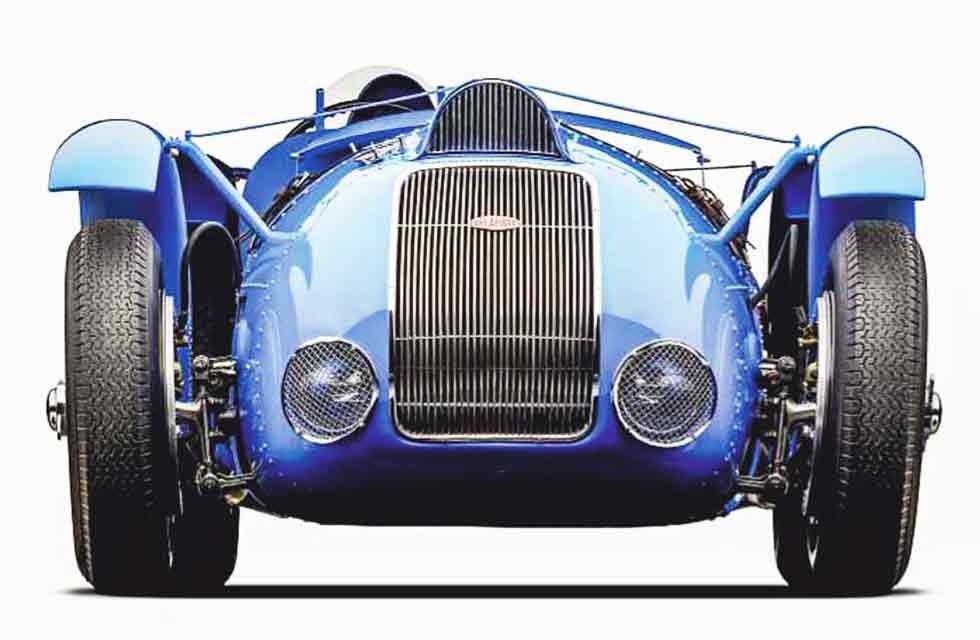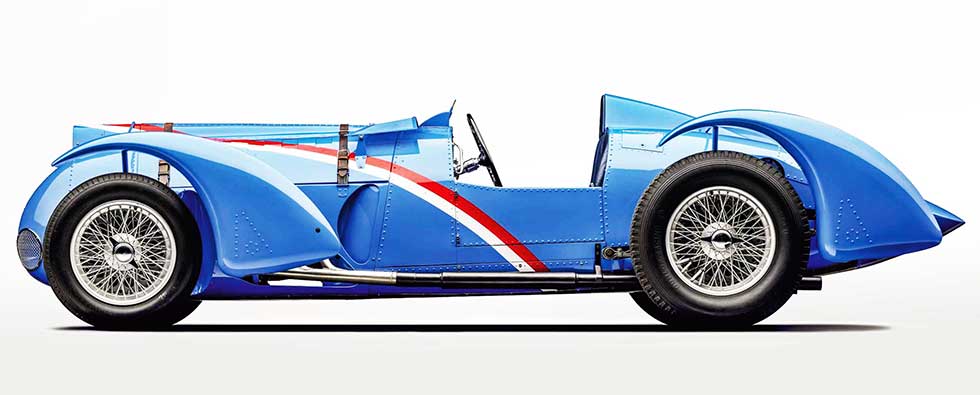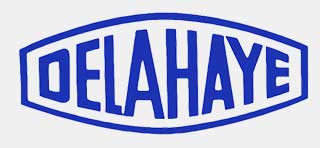
One in a million – incredible Delahaye V12. Money has always talked in Grand Prix racing – and a million francs was a big incentive for Delahaye to come up with a new car that might restore a nation’s pride Words David Burgess-Wise. Photography Michael Furman for Mullin Automotive Museum.
Million-Franc Delahaye
France’s V12-engined Grand Prix face-saver
When a new Grand Prix formula was introduced for 1934, the French were without a serious contender. And that’s particularly ironic because the French invented the Grand Prix in 1906, to ‘let the whole world know that French cars are the best’. While the new regulations left manufacturers with virtually a free hand, as long as they adhered to a maximum dry weight of 750kg and a minimum cross-section at the cockpit, French and Italian manufacturers offered little more than the previous year’s fare lightly warmed over. France’s Government-sponsored SEFAC racer (Société d’Etude et de Fabrication d’Automobile de Course) was over-complicated, overweight and underpowered. In contrast the Germans, who had no presence in Grand Prix racing, were galvanised into action by the announcement from the newly elected Reich Chancellor Adolf Hitler that Government funds would help to build a German national racing car as part of his campaign of ‘national motorisation’.

‘DELAHAYE FELT THAT THE NEW V12 WOULD STAND A CHANCE IN GRAND PRIX RACING UNDER THE NEW FORMULA FOR 1937’
Both Hitler’s favourite marque Mercedes-Benz and its rival Auto Union, which signed a contract with Ferdinand Porsche’s ‘High-Performance Vehicle Construction Company’ for the design of a 750kg racer, received subsidies and set to work from first principles, using lightweight materials and the latest technologies, to create world-beating racers.

The first sight the French public got of the new German racers was at the Grand Prix at Montlhéry on 1 July 1934. The mid-engined Auto Unions were described as ‘odd-looking’ by The Autocar, while the Mercedes were regarded as favourites, though their tyres were said to have a life of only eight laps. Incidentally, the legend about the cars being stripped of paint to get them under the 750kg weight limit is untrue; all three Mercedes team cars (finished in polished aluminium) were comfortably under the upper limit and it was the French Bugattis that had difficulty meeting the weight requirement. The German cars showed early promise but ultimately failed to deliver. As Sammy Davis of The Autocar wrote: ‘A crowd that had watched intelligently every move saw the Mercedes onslaught fall to pieces before their eyes.’ Nor did the Auto Unions do much better; the last to retire was Von Stuck’s, which lasted 32 laps out of 40. Indeed, only three Alfas covered the full distance and the only other car still running was Benoist’s Bugatti four laps behind, which was flagged off. Despite the inauspicious debut, in 1935 Mercedes finished 1-2-4 in the French Grand Prix, in which only one French car – Benoist’s Bugatti – had taken part (it retired after 16 laps). Veteran motoring journalist Charles Faroux called the German victory ‘la grande misère du sport automobile française’. Humiliated, the French sulked and declared that for 1936 its Grand Prix would be a race for sports cars, ‘a formula that, though it departs from the international formula, must interest the greatest possible number of competitors’.
‘The transformation of Delahaye in the mid-1930s was nothing short of miraculous. Designer Jean François is an unsung hero and the “Prix du Million” V12 racer was his masterpiece. Such a pity it wasn’t better-looking!’ Find out more about France’s heroic Grand Prix challenger on this article.
In an attempt to prove that France could still build cars that could outperform the seemingly invincible Germans, the Government announced a prize of a million francs (funded by adding five francs to the cost of every driving licence) to the manufacturer who could better by 10% the fastest laptime made by Rudolph Caracciola’s victorious Mercedes during the 1935 French Grand Prix at Montlhéry. Not just for one lap, but 16 – a distance of 200km. It meant an average of 146.508km/h. And it had to be done by midnight on 31 August 1937.
Three manufacturers stepped forward. A no-hoper in the shape of the Government-backed SEFAC, plus Bugatti and, surprisingly, Delahaye, a company that not long before had turned to making sports and luxury cars after years of building fairly pedestrian automobiles, lorries and fire engines. The impetus to go for the Prix du Million had come from a feisty lady named Lucy O’Reilly Schell, who had begun rallying specially developed sporting Delahayes in 1934, partnered by her husband Laury, an American long resident in France.
Lucy was the only child of a wealthy Irish-American named Francis P O’Reilly and his French wife Henrietta. Born near Paris in 1896, she had been competing since 1927 and nurtured ambitions of running a racing team on the lines of Enzo Ferrari’s Scuderia. She inherited her father’s fortune in 1936 and achieved that ambition, forming Ecurie Bleue, which enjoyed technical backing from the Delahaye factory but was entirely financed by Lucy. René Dreyfus, who had recently parted with Talbot, was recruited as Ecurie Bleue’s lead driver.
His mount for the Million was already taking shape at Delahaye. During the second half of 1936, engineer Jean François had started development of a new overhead-valve 4.5-litre 60º V12, a configuration not seen in competition since the Delage 2LCV Grand Prix car introduced in 1922. In the interests of lightness, the cylinder block was cast from magnesium, a daring move given the foundry techniques of the day and which gave great problems with porosity. The engine had a seven-bearing crankshaft and three camshafts, one between the blocks controlling the 12 inlet valves and one either side for six exhaust valves.
Delahaye felt that the new V12, although intended for a new sports model, would stand a chance in Grand Prix racing under the new formula for 1937, which limited engine capacity to 4.5 litres naturally aspirated or 3 litres supercharged, in conjunction with a sliding scale of weights linked to engine size. While the formula gave a power advantage to the supercharged cars, unblown cars offered lower fuel consumption and were kinder on tyres, hence less time spent in the pits.
The dual role of the new V12 Type 145 model was fortuitous, since Mercedes pleaded for a year’s delay in the introduction of the new formula. However, the Prix du Million still beckoned… Since the rules for the Million stipulated that the attempt had to be made by a manufacturer, the agreement was that the prize would be split between Delahaye as entrant and Ecurie Bleue, with a cut going to ‘works driver’ Dreyfus. Lucy Schell commissioned four Type 145 racers with lightweight two-seater bodies by the specialist coachbuilder Lecanu, three bodies designed by Jean François, and one by the coachbuilder’s proprietor, Olivier Lecanu Deschamp.
Unfortunately, Jean François was a better engineer than he was a bodywork designer and, when the Type 145 made its debut before the motoring press at Montlhéry on 25 June 1937, it got no marks for appearance. Gabriel Voisin wrote in his autobiography of an ill-favoured girl named Hélène de Bourg, of whom it was said, ‘temptation from the rear, compassion from the front’; the Type 145 was the automotive equivalent. While it had a pleasing slipper stern, an unkind critic likened its bulbous snout, designed round a large-capacity radiator and topped by a big air scoop for the carburettors, to Lucy’s pet bulldog. ‘It was,’ said Dreyfus, ‘the most awful-looking automobile I ever saw. But it was powerful.’
The Type 145 made its first racing appearance, fitted with mudguards, at the French Grand Prix at Montlhéry on 7 July, the last such race to be held under the dog-in-the-manger sports car formula. It was piloted by René Dreyfus, backed up by two Type 135 six-cylinder sports-racers driven by Laury Schell and René Carrière.
The entry of the new car had been ‘obviously regarded as a try-out’, commented The Autocar, adding: ‘Dreyfus, with the “flat-iron” Delahaye, was seen to slow. Mechanics rushed to change some of the 24 plugs. Dreyfus climbed out and shrugged to a Delahaye director. The car had not sounded right from the start, and on the seventh lap Dreyfus came in again. More·plugs were changed, the carburettor intake was blanked off with cardboard, all in the most leisurely style. After one more lap, and when a suspicious amount of oil had been dropped on the track, the 12-cylinder Delahaye retired from its first race.’
There was a second try-out at the Marne Grand Prix in Reims a couple of weeks later, which gave Dreyfus the chance to test the Type 145 against his rival for the Million, Jean-Pierre Wimille’s Bugatti. However, his tyres let him down during a scrap with the Bugatti and he spun off, cutting his wrist badly and leaving Wimille to run away with the race.
By late July, Dreyfus was testing a Type 145 every day at Montlhéry, with Jean François and a team of mechanics on hand making detail improvements. All the time he was expecting Wimille and the Bugatti – a T59 with a supercharged 3.3-litre engine – to arrive, but the Bugatti wasn’t ready and Wimille crashed on the way from Nice, delaying his attempt.
Finally, on 26 August, Delahaye’s works manager Charles Weiffenbach decided that the attempt would take place the following day. At 10am on the 27th, Dreyfus started his run. ‘I didn’t lift my foot,’ he recalled. ‘I couldn’t. This wasn’t a Grand Prix, this was a race against the clock and you can’t take time when you’re racing against it.’
Three laps from the end, the white breaker strip on the tyres was showing. The worried Dunlop representative lay flat in the grass to watch the tyres, but Dreyfus didn’t stop; he even did one more round after he’d been flagged at the end of 16 laps to signal the end of the run, just in case someone had miscounted.
‘You’ve done it!’ they told him: 1hr 21min 49.5sec – 146.654km/h, a margin of just 4.9sec. ‘I had the Million. For now…’ he said. But there were still four days to the deadline and the Bugatti and Wimille could still show. The Delahaye was taken back to the factory, checked over and fitted with new tyres. The next day it was back at the track, waiting.
Eventually, the Bugatti team arrived on 31 August with Jean Bugatti and team manager Robert Benoist in attendance. Wimille started his run at 4pm, but within a couple of laps his final drive failed. It was replaced; he started again at 6:43pm, followed two laps later by Dreyfus in the Delahaye, determined not to lose the Million at the last minute.
Signal boards at the control tower showed him three lap times: his current time, that of his previous run and Wimille’s. ‘On the first lap I was three seconds faster than my previous try and a second ahead of Jean-Pierre,’ he recalled. ‘On my next round, again faster than both, and on the next again.’ And then Wimille stopped: plug trouble. He started again, but after two more laps the attempt was abandoned. ‘The Million really was mine!’ exulted Dreyfus.
A triumphant Lucy ordered a red-and-white line to be painted across the blue bodywork of all her cars in celebration. The ‘Million’ car was proudly displayed at the Paris Salon in October. But was it really a match for the German onslaught? Well, the Million-winning 145 was victorious in the first race run under the new formula, the Pau Grand Prix of 10 April 1938. The tight city circuit suited the car, which was far quicker out of corners than the W154 Mercedes and didn’t need to pit for fuel. Dreyfus, who had come fourth in the Mille Miglia with a sister car, finished almost two minutes ahead of the Mercedes driven by Herman Lang, who had taken over the car from Caracciola at the halfway stage. ‘I don’t think I ever heard La Marseillaise played with such vigour,’ commented Dreyfus.
‘Victoire Française!’ shrieked a Delahaye poster with a drawing of a 145 that made it look almost handsome, but it was a false dawn. The French mechanics may have leapt with joy when the Delahaye took the chequered flag in the Cork Grand Prix two weeks after Pau, but there would be no more victories for it under the 1938 (or any other) formula.
Lucy Schell fell out with the Fonds de Course committee when it ruled out Delahaye from receiving further grants in 1938, awarding money to Talbot instead, and moved the Ecurie Bleue HQ to Monaco, boycotting that year’s Grand Prix. She gave up on the Delahayes in autumn 1939, switching to 8CTF Maseratis, and carried on even after the death of Laury in a car crash, entering the Maseratis for the 1940 Indianapolis 500, securing a leave of absence from the French Army for Dreyfus and René le Begue to drive them. France fell while they were still in America and, unsurprisingly, the half-Jewish Dreyfus decided to stay rather than return to an unlikely future under the Nazi occupation. He eventually became a famous restaurateur, owner of the Chanteclair restaurant in Manhattan, rendezvous of the racing fraternity in New York.
As for the Million Delahaye, there was a change of identity, too, and it would also eventually find a new home in America: after the war, its racing days over, new coachwork saw it transformed into an elegant road car. Meticulous recreation of its jolie laide racing body would come decades later…
THE DELAHAYE in these pictures will be displayed by Peter Mullin at the 2019 heveningham Concours in Suffolk on 22-23 June. See www.heveninghamconcours.com
TECHNICAL DATA FILE SPECIFICATIONS 1937 Delahaye Type 145 Grand Prix
Engine 4496cc 65º V12, OHV, three camshafts, triple Stromberg carburettors
Max Power 225bhp @ 5500rpm
Max Torque 256lb ft @ 2900rpm
Transmission Four-speed manual, rear-wheel drive
Suspension Front: transverse leaf springs, upper control arms, leverarm dampers. / Rear: live axle, semi-elliptic leaf springs, lever-arm dampers.
Brakes Hydraulic drums
0-62mph 6.0sec
Top speed c165mph
Top and above The camera rolls as Dreyfus prepares for his million-franc winning run at Montlhéry in August 1937; complex V12 engine features a cast magnesium block and three camshafts.






